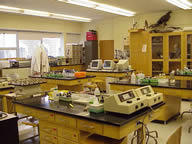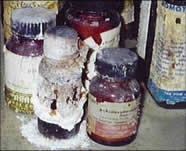Region 2
Serving New Jersey, New York, Puerto Rico, US Virgin Islands and Eight Tribal Nations.
Colleges and Universities
Environmental Assistance
Compliance Audits
Enforcement
Trade Associations 
- National Association of College and University Business Officers
- APPA (formerly Association of Physical Plant Administrators)
- Campus Safety Health and Environmental Management Association
- SEHSA: Environmental Health and Safety Association of NY, Inc.
- Association of Independent Colleges and Universities in NJ
- NJ Association of State Colleges and Universities
In the Spotlight
Scarlet Goes Green: Rutgers and EPA Partner to Reduce University's Environmental Impacts
 With more than 50,000 students, Rutgers, The State University of New Jersey, is one of the most highly-attended universities in the Northeast. Yet it is also one of the greenest. On November 13, 2009, Rutgers and the EPA signed an agreement to expand the school’s already strong environmental programs and commitments by outlining steps to reduce air pollution from vehicles, increase recycling, and improve water and energy use across the school’s three campuses. More
With more than 50,000 students, Rutgers, The State University of New Jersey, is one of the most highly-attended universities in the Northeast. Yet it is also one of the greenest. On November 13, 2009, Rutgers and the EPA signed an agreement to expand the school’s already strong environmental programs and commitments by outlining steps to reduce air pollution from vehicles, increase recycling, and improve water and energy use across the school’s three campuses. More
 New Rule Will Improve Environmental Performance of Academic Labs
New Rule Will Improve Environmental Performance of Academic Labs
EPA has finalized the Academic Laboratory rule to allow certain teaching and research laboratories to decide where (at the laboratory, at an on-site central accumulation area, or at an on-site treatment, storage or disposal facility) the hazardous waste determination is made provided certain conditions are met to protect human health and the environment. This flexibility not only allows eligible academic entities to determine the most effective and environmentally protective method of compliance, but it also ensures that a RCRA-trained professional will be making the hazardous waste determination. More
 The approximately 365 colleges and universities in Region 2 (New York, New Jersey, Puerto Rico, and U.S. Virgin Islands) are subject to a myriad of federal, state, and local environmental requirements as illustrated by the table below. Yet many colleges and universities have only one person responsible for understanding and complying with environmental regulations, many of whom are also responsible for the health and safety requirements as well. Lack of compliance with environmental requirements can not only result in significant penalties but can also put your staff and students at risk. For example, while inspecting one university, EPA found an art student's hands and forearms covered with blue paint, as were his clothes. The student was unaware that the paint he was using contained a metal compound to produce the brilliant blue color, or that this compound might be dangerous and toxic.
The approximately 365 colleges and universities in Region 2 (New York, New Jersey, Puerto Rico, and U.S. Virgin Islands) are subject to a myriad of federal, state, and local environmental requirements as illustrated by the table below. Yet many colleges and universities have only one person responsible for understanding and complying with environmental regulations, many of whom are also responsible for the health and safety requirements as well. Lack of compliance with environmental requirements can not only result in significant penalties but can also put your staff and students at risk. For example, while inspecting one university, EPA found an art student's hands and forearms covered with blue paint, as were his clothes. The student was unaware that the paint he was using contained a metal compound to produce the brilliant blue color, or that this compound might be dangerous and toxic.
Statute |
Requirements |
College Activity |
|---|---|---|
| Clean Air Act | New Source Performance Standards; Refrigerant Recycling Regulations; National Hazardous Air Pollutant Emission Standards; Risk Management Plans; State Implementation Plans; Greenhouse Gas Emissions |
Boilers; Air Conditioning and Refrigeration Equipment; Renovation/Demolition Activities; Power Plant; Bulk Chemical Storage; Vehicle Maintenance |
| Clean Water Act | Spill Prevention, Control, and Countermeasure Requirements; Stormwater Management; Pollutant Discharge Permits | Bulk Oil Storage; Construction Activities; Cafeterias; Vehicle Maintenance; Drains; Laboratories; Medical Clinics; Waste Water Treatment Plants |
| Emergency Planning and Community Right to Know Act | Material Safety Data Sheets, Toxic Release Inventory Reporting; Emergency Planning Notification; Hazardous Chemical Storage Reporting; Emergency Release Notification | Laboratories; Bulk Chemical Storage; Athletic Department; Bulk Oil Storage; Vehicle Maintenance |
| Fungicide, Insecticide, and Rodenticide Act | Certification of Pesticides Applicators; Use and Storage of Pesticides | Grounds Keeping; Medical Clinics, Building Maintenance; Cafeterias |
| Resource Conservation and Recovery Act | Hazardous Waste Generator Requirements; Underground Storage Tank Regulations; Solid Waste Management; Universal Waste Requirements | Art Studios; Laboratories; Bulk Oil Storage; Vehicle Maintenance; Campus Housing; Cafeterias; Medical Clinics |
| Safe Drinking Water Act | Underground Injection Control Requirements | Drains; Vehicle Maintenance; |
| Toxic Substance Control Act | Lead Paint Requirements; PCB Requirements | Renovation Activities; Child Care Centers; Power Plant; Caulk in Buildings |

We strongly urge colleges and universities to conduct compliance audits and voluntarily disclose violations under EPA’s Audit Policy. Under this policy, EPA can reduce or eliminate civil penalties provided certain conditions are met. New York State Department of Environmental Conservation as well as Rutgers University have created checklists which we encourage you to use. There is no reason to reinvent the wheel.
If you are not able to conduct a full facility audit, at a minimum, we recommend you to look closely at your hazardous waste management practices. The majority of all violations disclosed to EPA from voluntary audits conducted by colleges and universities under EPA’s audit policy relate to hazardous waste. Thus, it is a very good place to start.
